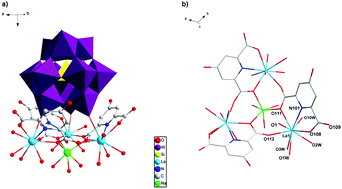Syntheses, structures, properties and DFT study of hybrid inorganic–organic architectures constructed from trinuclear lanthanide frameworks and Keggin-type polyoxometalates†
Abstract
In this paper we report the synthesis and X-ray characterization of four novel hybrid inorganic–organic assemblies generated from H4SiW12O40 as Keggin-type polyoxometalates (POM) and, in three of them, a trinuclear lanthanide cluster of type {Na(H2O)3[Ln(HCAM)(H2O)3]3}4+ is formed, where Ln metal is La in compound 1, Ce in compound 2, and Eu in compound 3 (H3CAM = chelidamic acid or 2,6-dicarboxy-4-hydroxypyridine). These compounds represent the first POM-based inorganic–organic assemblies using chelidamic acid as an organic ligand. The thermal stability of the organic ligand is crucial, since pyridine-2,6-bis(monothiocarboxylate) instead of chelidamic acid is used (compound 4) under the same synthesis conditions, the decomposition of the ligand to pyridine was observed leading to the formation of colorless crystals of a pseudo hybrid inorganic–organic assembly. In compound 4 the hybrid inorganic–organic assembly is not formed and the organic part simply consists of four molecules of protonated pyridine acting as counterions of the [SiW12O40]4– counterpart. The luminescent properties of compounds 1 and 3 have been investigated and their solid state architectures have been analyzed. Whereas compound 1 only shows ligand emission, the Eu3+ emission in compound 3 is discussed in detail. We have found that unprecedented anion–π interactions between the POM, which is a tetra-anion, and the aromatic rings play a crucial role in the crystal packing formation. To the best of our knowledge, this is the first report that describes and analyzes this interaction in Keggin-type POM based inorganic–organic frameworks. The energetic features of these interactions in the solid state have been analyzed using DFT calculations in some model systems predicted by us.


 Please wait while we load your content...
Please wait while we load your content...